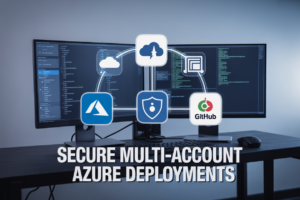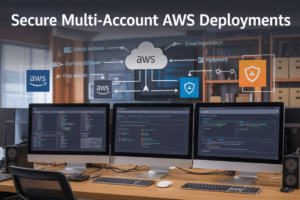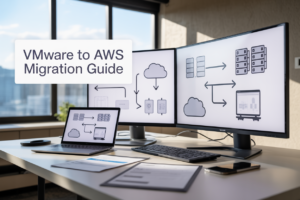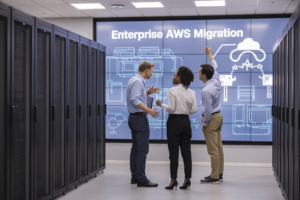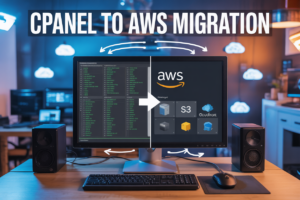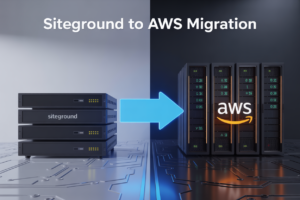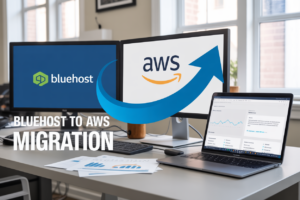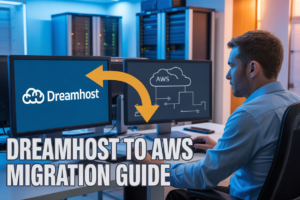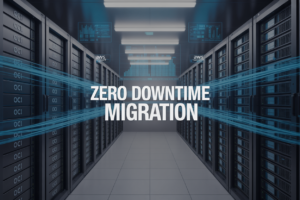Deploying Go applications to the cloud doesn’t have to be overwhelming. This comprehensive guide walks you through containerizing Go applications and deploying them on AWS ECS, giving you the practical skills to move from local development to production-ready infrastructure.
Who this guide is for: Go developers ready to containerize their applications, DevOps engineers working with Go microservices, and teams looking to streamline their deployment process using Docker and AWS services.
You’ll learn how to build and test Docker images locally for your Go applications, ensuring your containerized apps run smoothly before deployment. We’ll also cover setting up AWS ECS clusters and task definitions to host your Go applications reliably in the cloud. Finally, you’ll discover how to automate your entire deployment workflow using CI/CD pipelines that push images to Amazon ECR and deploy them seamlessly to your ECS infrastructure.
By the end, you’ll have a complete understanding of the Go containerization AWS ECS workflow and the confidence to deploy scalable Go applications in production environments.
Setting Up Your Go Application for Containerization
Structuring your Go project for Docker compatibility
Organize your Go application with a clean directory structure that separates source code, configuration files, and Docker assets. Place your main application code in a cmd/ directory, business logic in internal/, and shared packages in pkg/. Create a dedicated .dockerignore file to exclude unnecessary files like .git, documentation, and local configuration files from your Docker build context. This approach reduces image size and improves build performance while maintaining code clarity.
Creating optimized Dockerfiles for production deployment
Build efficient Docker images using multi-stage builds to minimize production image size. Start with the official Go image for compilation, then copy the compiled binary to a minimal base image like alpine or scratch. Pin specific Go versions to ensure consistent builds across environments. Set appropriate user permissions by creating a non-root user and configure the working directory properly. Enable Go modules caching between builds by copying go.mod and go.sum files before copying source code, allowing Docker to cache dependency downloads.
Implementing health checks and logging best practices
Add HTTP health check endpoints to your Go application that verify database connections and external service availability. Configure Docker health checks using the HEALTHCHECK instruction in your Dockerfile, pointing to your application’s health endpoint. Implement structured logging with libraries like logrus or zap to output JSON-formatted logs that integrate seamlessly with AWS CloudWatch. Set appropriate log levels and ensure sensitive information is never logged. Configure your application to write logs to stdout/stderr for proper container log collection.
Managing environment variables and configuration files
Design your Go application to read configuration from environment variables rather than hardcoded values. Use libraries like viper or godotenv for flexible configuration management. Create separate configuration files for different environments (development, staging, production) and use Docker’s ENV instructions or external configuration services. Avoid embedding secrets directly in Docker images; instead, use AWS Systems Manager Parameter Store or AWS Secrets Manager for sensitive data. Validate required environment variables at application startup to catch configuration issues early in the deployment process.
Building and Testing Docker Images Locally
Writing multi-stage Docker builds for smaller image sizes
Multi-stage Docker builds dramatically reduce Go application image sizes by separating build dependencies from runtime requirements. Start with a full Go builder image to compile your application, then copy only the binary to a minimal base image like alpine or distroless. This approach can shrink images from gigabytes to under 50MB.
# Build stage
FROM golang:1.21-alpine AS builder
WORKDIR /app
COPY go.mod go.sum ./
RUN go mod download
COPY . .
RUN CGO_ENABLED=0 GOOS=linux go build -o main .
# Runtime stage
FROM alpine:latest
RUN apk --no-cache add ca-certificates
WORKDIR /root/
COPY --from=builder /app/main .
CMD ["./main"]
Running containerized Go applications on your development machine
Testing your containerized Go app locally ensures smooth AWS ECS deployment. Build your image using docker build -t myapp ., then run it with proper port mapping: docker run -p 8080:8080 myapp. Use environment variables for configuration and mount volumes for development files. Docker Compose simplifies multi-service setups with databases or external dependencies your Go application requires.
version: '3.8'
services:
app:
build: .
ports:
- "8080:8080"
environment:
- ENV=development
volumes:
- .:/app
Debugging common containerization issues and solutions
Go containerization debugging starts with checking your binary compilation flags. Set CGO_ENABLED=0 to avoid libc dependencies that cause “file not found” errors in minimal images. Use docker logs <container-id> to view application output and docker exec -it <container-id> sh to inspect the container filesystem. Network connectivity issues often stem from binding to localhost instead of 0.0.0.0. Time zone problems require copying /usr/share/zoneinfo or setting the TZ environment variable.
Preparing AWS Infrastructure for ECS Deployment
Setting up VPC networks and security groups for container access
Creating a secure network foundation starts with establishing a VPC with both public and private subnets across multiple Availability Zones. Public subnets host your Application Load Balancer, while private subnets contain your ECS tasks for enhanced security. Configure security groups to allow inbound traffic on port 80/443 for the load balancer and restrict container access to only necessary ports. Set up NAT Gateways in public subnets to enable outbound internet access for containers in private subnets, essential for pulling Docker images and external API calls.
Creating IAM roles and policies for ECS task execution
ECS requires specific IAM roles to function properly with your Go containerization AWS ECS deployment. Create an ECS Task Execution Role with the AmazonECSTaskExecutionRolePolicy attached, enabling ECS to pull images from Amazon ECR and write logs to CloudWatch. Add a Task Role with custom policies granting your Go application access to required AWS services like S3, DynamoDB, or Parameter Store. Include permissions for ECR image pulls and CloudWatch logging to ensure smooth container operations.
Configuring Application Load Balancers for traffic distribution
Deploy an Application Load Balancer in your public subnets to distribute incoming requests across your ECS tasks. Create target groups pointing to your ECS service, configuring health checks on your Go application’s health endpoint (typically /health or /ping). Set up listener rules to route traffic based on paths, headers, or hostnames. Configure SSL certificates through AWS Certificate Manager for HTTPS termination, and enable connection draining to ensure graceful deployments without dropping active connections.
Establishing RDS databases and other AWS services integration
Provision RDS instances in private subnets with appropriate security groups allowing access only from your ECS tasks. Create database subnet groups spanning multiple Availability Zones for high availability. Set up Parameter Store or Secrets Manager to securely store database credentials and connection strings. Configure VPC endpoints for services like S3 and ECR to reduce data transfer costs and improve security. Establish CloudWatch log groups for your Go application logs and set up appropriate retention policies for cost optimization.
Pushing Docker Images to Amazon ECR
Creating and configuring ECR repositories securely
Amazon ECR serves as your private Docker registry, storing containerized Go applications securely within your AWS environment. Create repositories through the AWS Console or CLI, enabling encryption at rest and configuring resource-based policies to control access. Set up IAM roles with minimal permissions, granting only necessary ECR actions like GetAuthorizationToken and BatchGetImage to your deployment pipelines and ECS services.
Authenticating Docker client with AWS ECR
AWS ECR requires authentication tokens that expire every 12 hours, making automated credential management essential for Go application deployment workflows. Use the AWS CLI command aws ecr get-login-password piped to docker login for seamless authentication. Configure your CI/CD pipelines with appropriate AWS credentials, either through IAM roles for EC2 instances or access keys stored securely in your deployment environment.
Implementing automated image scanning and vulnerability detection
ECR’s built-in vulnerability scanning automatically analyzes your Go Docker images for known security issues using the Common Vulnerabilities and Exposures (CVE) database. Enable scan-on-push functionality to automatically scan new image versions, receiving detailed reports highlighting critical vulnerabilities in base images and dependencies. Configure scan results to integrate with your deployment gates, preventing vulnerable images from reaching production environments.
Managing image lifecycle policies for cost optimization
Image lifecycle policies automatically delete old or unused Docker images, reducing ECR storage costs while maintaining your Go application’s deployment history. Create rules based on image age, count, or tagged status to retain only necessary versions. Set policies to keep the latest 10 production images while removing development builds older than 30 days, balancing cost optimization with rollback capabilities for your containerized Go applications.
Tagging strategies for version control and deployment tracking
Implement consistent Docker image tagging strategies combining semantic versioning with deployment metadata for effective Go application management. Use tags like v1.2.3-prod, latest, and commit SHA combinations to track deployments across environments. Create immutable tags for production releases while using mutable tags for development iterations, enabling precise rollbacks and deployment tracking across your AWS ECS infrastructure.
Creating ECS Clusters and Task Definitions
Choosing between EC2 and Fargate launch types for optimal performance
Fargate eliminates server management overhead and offers automatic scaling, making it perfect for Go microservices AWS ECS deployments with unpredictable traffic patterns. EC2 launch types provide greater control over underlying infrastructure and cost optimization for consistent workloads. Consider Fargate for development environments and smaller applications, while EC2 works better for large-scale production systems requiring custom AMIs or specialized hardware configurations.
Defining resource allocation and scaling parameters
Your Go application’s memory and CPU requirements directly impact ECS task definition configuration. Start with conservative allocations – typically 512 MB memory and 256 CPU units for basic Go services. Configure auto-scaling policies based on CPU utilization (target 70%) and memory usage thresholds. Set minimum and maximum task counts to handle traffic spikes while controlling costs. Go applications generally require less memory than Java alternatives, allowing for efficient resource utilization across your AWS ECS cluster setup.
Configuring networking modes and service discovery
VPC mode provides isolated networking for production Go containerization AWS ECS deployments, enabling security groups and network ACLs. Configure Application Load Balancer target groups to distribute traffic across healthy tasks. Enable AWS Cloud Map service discovery to allow internal service communication without hard-coded endpoints. Set up private subnets for backend services and public subnets for load balancer placement. Network performance impacts Go application latency, so choose availability zones strategically.
Setting up logging drivers and monitoring integration
CloudWatch Logs driver captures stdout and stderr from your containerized Go applications automatically. Configure log groups with appropriate retention policies to manage storage costs. Integrate AWS X-Ray for distributed tracing across Go microservices. Set up CloudWatch Container Insights for cluster-level metrics and performance monitoring. Custom metrics from your Go application can be published using AWS SDK, enabling comprehensive observability for your Docker Go application deployment pipeline.
Deploying and Managing Go Applications on ECS
Creating ECS services with auto-scaling capabilities
ECS services provide the foundation for running containerized Go applications with built-in load balancing and auto-scaling. Start by creating a service that references your task definition and specifies the desired number of running tasks. Configure Application Auto Scaling to automatically adjust capacity based on metrics like CPU utilization or memory consumption. Set target tracking policies that maintain optimal performance while controlling costs – for example, scaling out when CPU exceeds 70% and scaling in when it drops below 30%. Define minimum and maximum task counts to prevent over-provisioning and ensure availability during traffic spikes.
Implementing blue-green and rolling deployment strategies
Rolling deployments update your Go application gradually by replacing old tasks with new ones, maintaining service availability throughout the process. Configure the deployment configuration with minimumHealthyPercent and maximumPercent parameters to control how many tasks can be stopped or started simultaneously. Blue-green deployments create a complete duplicate environment running the new version before switching traffic, offering zero-downtime deployments with instant rollback capabilities. Use AWS CodeDeploy with ECS to orchestrate blue-green deployments, automatically handling traffic shifting and health checks between environments.
Monitoring application performance and container health
ECS integrates with CloudWatch to provide comprehensive monitoring of your Go applications and underlying infrastructure. Enable Container Insights to collect detailed metrics about CPU, memory, network, and disk utilization at both cluster and service levels. Configure custom metrics from your Go application using the AWS SDK to track business-specific KPIs alongside infrastructure metrics. Set up CloudWatch alarms for critical thresholds and create dashboards that visualize application performance trends. Use AWS X-Ray for distributed tracing to identify bottlenecks in microservices architectures and optimize your Go application’s performance across service boundaries.
Troubleshooting deployment failures and service connectivity issues
Common ECS deployment failures stem from incorrect task definitions, insufficient resources, or networking misconfigurations. Check CloudWatch Logs for container startup errors and validate that your Go application handles signals properly for graceful shutdowns. Verify security group rules allow necessary traffic between services and load balancers. Use ECS Exec to access running containers for debugging, similar to docker exec but for ECS tasks. When services fail health checks, examine the target group configuration and ensure your Go application responds correctly to health check endpoints with appropriate HTTP status codes.
Automating Deployments with CI/CD Pipelines
Setting up GitHub Actions or AWS CodePipeline for continuous deployment
GitHub Actions offers seamless integration with your Go application repository, automatically triggering builds when code changes occur. Create a .github/workflows/deploy.yml file that builds your Docker image, pushes it to Amazon ECR, and updates your ECS service. AWS CodePipeline provides native AWS integration, connecting source repositories to CodeBuild for compilation and CodeDeploy for ECS deployment. Both platforms support environment variables for secure credential management and can trigger deployments across multiple environments like staging and production.
Implementing automated testing before container deployment
Your Go application CI/CD pipeline should include comprehensive testing stages before Docker image deployment. Run unit tests using go test ./..., execute integration tests against containerized dependencies, and perform security scans with tools like Trivy or Clair. Configure your pipeline to halt deployment if tests fail, ensuring only validated code reaches production. Include linting with golangci-lint, vulnerability scanning, and load testing to catch performance regressions. Test your Docker image locally using multi-stage builds that separate testing from production artifacts.
Creating rollback mechanisms for failed deployments
ECS blue-green deployments provide zero-downtime rollbacks when new container versions fail health checks. Configure your deployment pipeline to automatically revert to the previous task definition if deployment validation fails. Implement health check endpoints in your Go application that return detailed status information, allowing ECS to make informed decisions about container health. Use AWS CloudWatch alarms to monitor application metrics and trigger automatic rollbacks when error rates exceed thresholds. Store previous task definition versions and container images to enable quick manual rollbacks when needed.
Deploying Go applications on AWS ECS doesn’t have to be overwhelming when you break it down into manageable steps. We’ve walked through everything from containerizing your Go app and building Docker images to setting up ECS clusters and creating robust CI/CD pipelines. Each step builds on the previous one, creating a solid foundation for running your applications in the cloud with confidence.
The real game-changer here is automation. Once you’ve set up your CI/CD pipeline, deploying updates becomes as simple as pushing code to your repository. Your Go applications will scale automatically, handle traffic spikes gracefully, and give you the reliability that comes with AWS’s managed infrastructure. Take your time with each step, test thoroughly in development, and you’ll have a production-ready deployment process that serves you well for years to come.











